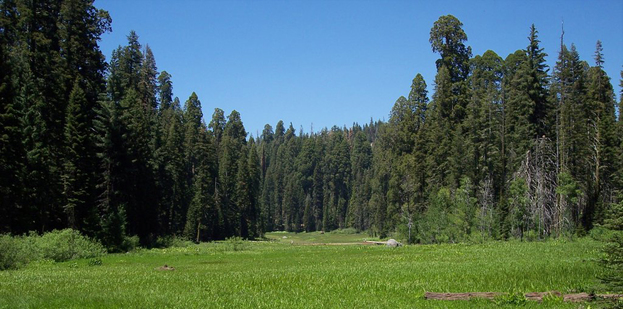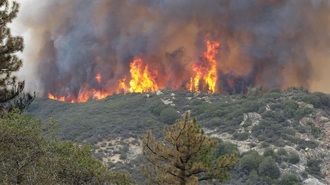"One Watershed" Series
|
#6 Watershed Connections: Forest Health and Its Impacts Downstream
October 14, 2015
 Crescent Meadow, Giant Forest Crescent Meadow, Giant Forest
Mountain forests are more than a pretty place, more than tall trees and expansive meadows, more than a destination for winter snow play and summer river splashing.
The forest provides hundreds of natural services, upon which we all depend. More than 50% of California’s water supply comes from rivers that begin in the Sierra Nevada. Persistent drought, past forest management strategies, federal budget decisions, air pollution, and climate change are impacting the health and function of the forests. Fire, a hot topic on everyone’s mind, has important implications for water and other natural resources.  Rough Fire has burned more than 150,000 acres in Fresno County. Rough Fire has burned more than 150,000 acres in Fresno County.
Fire
In the past 100 years, half of the largest 20 fires recorded in California have occurred in the past 10 years, including the recent Rough Fire, which has burned more than 150,000 acres and continues to smolder. In this fourth year of drought, hot and dry conditions have “reduced moisture in both live and dead trees, as well as shrub leaves and tree needles, which allows for more efficient fire initiation and high intensity burns,” said Scott Stephens, Professor of Fire Science at UC Berkeley. Not only is the forest dry, but it has attracted an infestation of western pine beetles that prey on stressed pine trees. Drought, dense pine stands, and Valley air pollution make the trees particularly vulnerable to beetle outbreaks. If you’ve taken a trip up to Kings or Sequoia National Parks lately, then you’ve seen the drought’s dramatic toll and how flammable parts of the forest appear. Federal budget decisions have also affected the Forest Service’s ability to minimize damage from wildfires. More than half of the Forest Service’s annual budget is spent on firefighting. Twenty years ago, firefighting accounted for 16% of the budget. Within ten years, that figure is expected to climb to two-thirds of the budget. “We have to move from fire suppression and containment to fire prevention through forest management,” said Mohammad Safeeq, Research Scientist at UC Merced’s Sierra Nevada Research Institute. “We [at SNRI] are invested in … demonstrating the measurable benefits of prescribed forest burns and tree thinning on fire risk, carbon storage, and water yield,” said Safeeq.  Tree die-off, Sequoia National Forest Tree die-off, Sequoia National Forest
Forest Management
Fire suppression has been a dominant philosophy in the forests for about a century. Extensive suppression has led to high vegetation density, which fuels fires that burn with higher intensity. Some scientists are concerned that high-intensity fires, such as the 2013 Rim Fire that burned 257,000 acres in and around Yosemite, could permanently impact ecosystems. To reduce ecosystem damage, scientists recommend increased fuel-reduction treatments such as prescribed forest burning and thinning. Several efforts are underway to study the effects of such treatments on overall watershed health. For the past 13 years, the Kings River Experimental Watersheds (KREW) study has been monitoring watershed variables. The goal is to make data available to guide managers in decisions that help the forest provide the ecosystem services upon which humans and wildlife depend. In 2012 and 2013, the KREW team implemented tree thinning and prescribed fire as a means of restoring forest health. “The fact is, if you want to improve forest health and do it in a responsible and effective way, you need data and information,” said Carolyn Hunsaker, Forest Service scientist leading the KREW project. Before KREW, very little was known about headwater streams and watersheds in the southern Sierra Nevada. Hunsaker said that while they’re still gathering data, observations indicate that forest thinning followed by low-intensity burning shows promise for safely returning the forest to pre-1850 conditions, when the Sierra gold rush and fire suppression strategies began. Early results should be available in 2016.  More than 50% of California’s water descends from the Sierra Nevada (photo by Bobby Kamansky) More than 50% of California’s water descends from the Sierra Nevada (photo by Bobby Kamansky)
Water
One of the top priorities of Hunsaker’s study, and other efforts throughout the state, is to increase long-term water yield and forest health without short-term impacts on water quality and other resources like soils and wildlife habitat. “What it should do, if all goes well, is increase water quantity,” said Hunsaker. By reducing the number of plants and trees, forest managers expect to reduce the amount of water used by the trees and then transpired into the atmosphere, freeing up more water to travel downstream. If managers thin about 25-50% of the trees in strategic areas, you can increase water flow into streams by 9-16%, according to Roger Bales, engineering professor at the University of Merced and Director of the Sierra Nevada Research Institute. Computer model estimates suggest a possible water yield increase of 500,000 to 1 million acre feet a year across the Sierra, enough for up to five million people, according to Bales. The KREW study also aims to demonstrate how carefully planned and implemented forest management can affect water quality. “It should help avoid massive wildfires that cause erosion and sediment issues impacting streams, reservoirs, fish, and other aquatic species,” said Hunsaker. The Rough Fire highlights the important connection between forest management and downstream water quality. According to Steven Haugen, Watermaster for the Kings River, about 14% of the Kings River watershed has been scorched by the Rough Fire. He is concerned about fire debris and sediment that will impact the reservoir and fisheries. Predictions of a strong El Niño year introduce additional concern. “The combination of extreme drought, large-scale disturbances from fire, steep slopes in the southern Sierra, and an extreme El Niño event could severely impact water quality from erosion and sediment,” said Bobby Kamansky, principal biologist for Kamansky's Ecological Consulting. Climate Change All of today’s forest management challenges get magnified under the lens of climate change. “The combination of high fuel loads and increasing temperatures due to climate warming may well be bringing our forests to a tipping point,” said Bales. “A sustainable forest in a warmer climate may be different from the sustainable forest of 100-150 years ago,” he added. With warmer temperatures, more precipitation will fall as rain instead of snow and snow will melt earlier in the season, reducing dry season river flow. “Increase in temperature by one to two degrees makes a big difference and this is something we cannot ignore,” said Safeeq. “Reduced snowpack and long dry summers are going to be the new normal and we have to find ways to adapt,” he added. “The crisis is that our forests are changing,” said Kamansky. “Nature is dynamic and adaptable. Humans aren’t adapting fast enough, which makes us vulnerable to catastrophe,” he said. Kamansky suggests that one way we can adapt is to accept that fire is one of nature’s age-old sustainability strategies, and then learn how to work with it. About 50% of the Sierra Nevada forests are publicly owned, which makes the future of forest management an issue for all of us. The long-term maintenance of water quality and quantity in California requires downstream distributors and users to understand where the water comes from and what affects it, from the forest to the faucet. Authored by Niki Woodard, Communications Specialist for the Tulare Basin Wildlife Partners and Tulare Basin Watershed Initiative. She has been working with land conservation and watershed health initiatives in the San Joaquin Valley for the past seven years. Niki also works for the Center for Climate Protection.
|
Mission: To raise awareness about the Tulare Lake Watershed and its unique attributes, challenges, and opportunities. From the snowy peaks to the valley floor, we are one watershed.
This project is made possible by grant funding from the Central Valley Community Foundation, formerly the Fresno Regional Foundation.
This project is part of the Tulare Basin Watershed Initiative.
HELPFUL LINKS:
|




